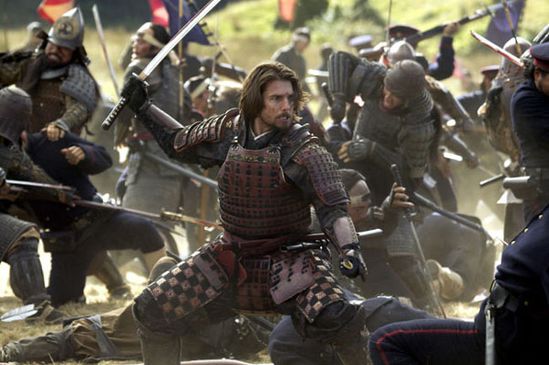
Samurai usually referred to in Japanese as bushi or buke were the military nobility of medieval and early-modern Japan.
In both countries the terms were nominalized to mean "those who serve in close attendance to the nobility," the pronunciation in Japanese changing to saburai. According to Wilson, an early reference to the word "samurai" appears in the Kokin Wakash? (905–914), the first imperial anthology of poems, completed in the first part of the 10th century.

By the end of the 12th century, samurai became almost entirely synonymous with bushi, and the word was closely associated with the middle and upper echelons of the warrior class. The samurai followed a set of rules that came to be known as bushid?. While the samurai numbered less than 10% of Japans population, their teachings can still be found today in both everyday life and in modern Japanese martial arts.
Samurai employed a range of weapons such as bows and arrows, spears and guns, but their main weapon and symbol was the sword.

Samurai were supposed to lead their lives according to the ethic code of bushido ("the way of the warrior"). Strongly Confucian in nature, bushido stressed concepts such as loyalty to ones master, self discipline and respectful, ethical behavior. Many samurai were also drawn to the teachings and practices of Zen Buddhism.
The samurai trace their origins to the Heian Period campaigns to subdue the native Emishi people in the Tohoku Region. Around the same time, warriors were increasingly hired by wealthy landowners that had grown independent of the central government and built armies for their own protection.
Some Video documentaries on Samurai Warriors
The two most powerful of these landowning clans, the Minamoto and Taira, eventually challenged the central government and battled each other for supremacy over the entire country. Minamoto Yoritomo emerged victorious and set up a new military government in 1192, led by the shogun or supreme military commander. The samurai would rule over Japan for most of the next 700 years.
During the chaotic era of warring states in the 15th and 16th centuries, Japan splintered into dozens of independent states constantly at war with one another. Consequently, warriors were in high demand. It was also the era when ninja, warriors specialized in unconventional warfare, were most active. Many of the famous samurai movies by Kurosawa are set during this time.
The country was eventually reunited in the late 1500s, and a rigid social caste system was established during the Edo Period that placed the samurai at the top, followed by the farmers, artisans and merchants respectively. During this time, the samurai were forced to live in castle towns, were the only ones allowed to own and carry swords and were paid in rice by their daimyo or feudal lords. Masterless samurai were called ronin and caused minor troubles during the 1600s.
Relative peace prevailed during the roughly 250 years of the Edo Period. As a result, the importance of martial skills declined, and many samurai became bureaucrats, teachers or artists. Japans feudal era eventually came to an end in 1868, and the samurai class was abolished a few years afterwards.
Samurai Culture
The culture of the samurai was grounded in the concept of bushido - "the way of the warrior." The central tenets of bushido are honor and freedom from the fear of death. A samurai was legally entitled to cut down any commoner who failed to honor him (or her) properly. A warrior imbued with bushido spirit would fight fearlessly for his master, and die honorably rather than surrender in defeat.
Out of this disregard for death, the Japanese tradition of seppuku evolved: defeated warriors (and disgraced government officials) would commit suicide with honor by ritually disemboweling themselves with a short sword.
Samurai Weapons
Early samurai were archers, fighting on foot or horseback with extremely long bows (yumi). They used swords mainly for finishing off wounded enemies.
After the Mongol invasions of 1272 and 1281, the samurai began to make more use of swords, as well as poles topped by curved blades called naginata, and spears.
Samurai warriors wore two swords, together called daisho - "long and short." The katana, a curved blade over 24 inches long, was suitable for slashing, while the wakizashi, at 12-24 inches, was used for stabbing. In the late 16th century, non-samurai were forbidden to wear the daisho.

Samurai wore full body-armor in battle, often including a horned helmet.
The Samurai Myth
Modern Japanese honor the memory of the samurai, and bushido still infuses the culture. Today, however, the samurai code is invoked in corporate boardrooms rather than on the battlefield.
Even now, everyone knows the story of the 47 Ronin, Japans "national legend." In 1701, the daimyo Asano Naganori drew a dagger in the shoguns palace and tried to kill Kira, a government official. Asano was arrested, and forced to commit seppuku. Two years later, forty-seven of his samurai hunted down Kira and killed him, without knowing Asanos reasons for attacking the official. It was enough that he wanted Kira dead.
Since the ronin had followed bushido, the shogun allowed them to commit seppuku instead of being executed. People still offer incense at the graves of the ronin, and the story has been made into a number of plays and films.
More Info documentaries on Samurai
References CC BY SA
Samurai (侍?) were the militarynobility and officer caste ofmedieval and early-modern Japan.In Japanese, they are usuallyreferred to as bushi (武士?,[bu.ɕi]) or buke (武家?). Accordingto translator William ScottWilson: "In Chinese, the character侍 was originally a verb meaning"to wait upon" or "accompanypersons" in the upper ranks ofsociety, and this is also true ofthe original term in Japanese,saburau. In both countries theterms were nominalized to mean"those who serve in closeattendance to the nobility", thepronunciation in Japanese changingto saburai. According to Wilson,an early reference to the word"samurai" appears in the KokinWakashū (905–914), the firstimperial anthology of poems,completed in the first part of the10th century.
